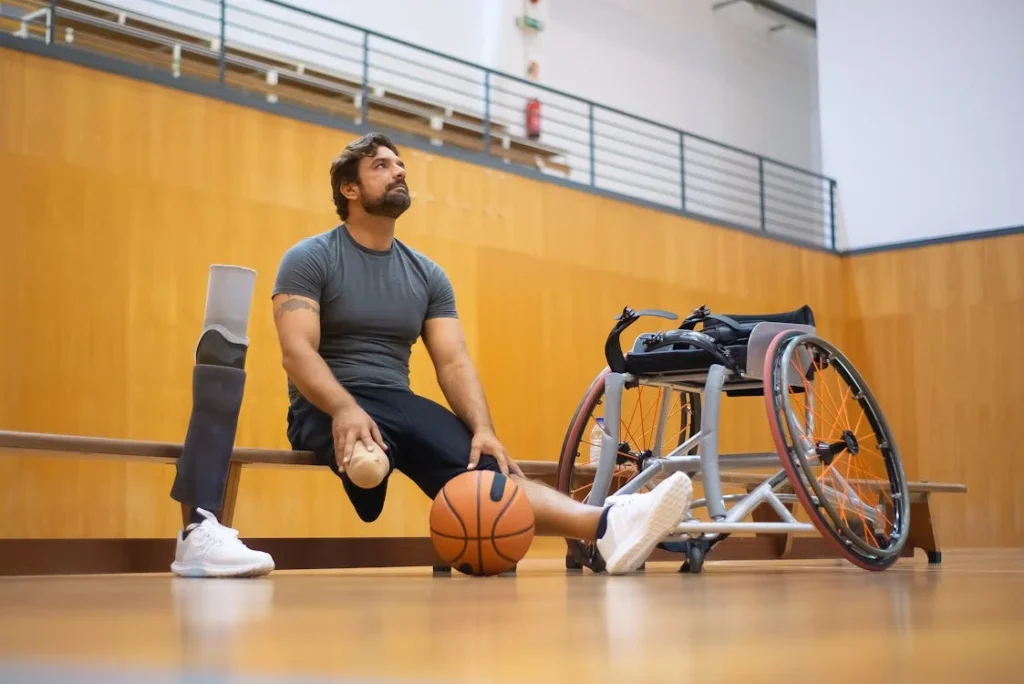Learning how to walk again after an amputation is one of the most challenging journeys a person can face. When it comes to prosthetic rehabilitation, not all journeys are the same. Two major types of lower-limb amputations — transtibial (below the knee) and transfemoral (above the knee) — come with very different challenges, especially during gait training.
The way a person learns to walk after each type of amputation can look and feel completely different. This isn’t just because of how high the amputation is. It’s about how the body moves, how much effort it takes, and what kind of support the prosthetic can give. For both types, training the body and the mind to adapt is a long but rewarding process.
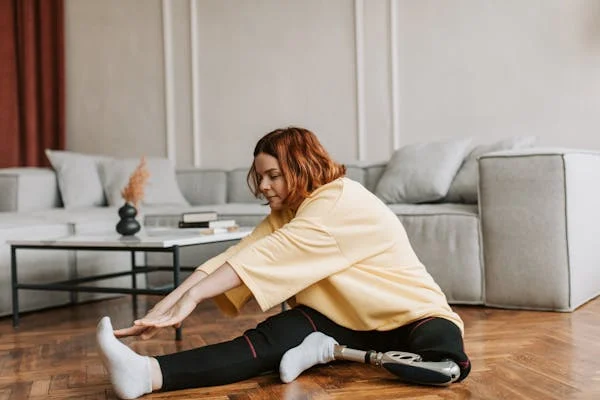
Understanding Gait Training After Lower Limb Amputation
What Is Gait Training, Really?
Gait training is not just about walking. It’s about teaching the body how to move in a way that feels natural and balanced after a major change — like losing a limb.
When a person loses a leg, the way their entire body moves, stands, shifts weight, and even balances changes completely.
Gait training is the process of helping that person build new patterns of movement using a prosthesis. It’s physical therapy, but also a form of muscle re-education.
And at the same time, it’s a mental challenge, because the brain must learn to trust a new limb that isn’t part of the original body.
After an amputation, muscles weaken. Joints get stiff. The body is off balance. Simple actions like stepping forward, climbing stairs, or turning can feel foreign and difficult.
Gait training focuses on breaking down each of these movements, correcting posture, strengthening muscles, and improving coordination. It also helps prevent long-term issues like joint strain or uneven walking patterns that could lead to pain or injury over time.
The Role of the Residual Limb and Type of Amputation
Now, this is where things start to differ depending on the type of amputation. In transtibial amputations, the knee joint is still there. This makes a huge difference.
The person can still bend and straighten their knee, which is one of the key movements in walking. This gives them more control and makes it easier to learn certain walking techniques.
In transfemoral amputations, however, the knee is gone. This creates a bigger challenge. A prosthetic knee has to replace what was once a natural joint — and while technology has come a long way, there’s no true replacement for the body’s own knee in terms of fluidity and instinctive movement.
So, gait training for transfemoral amputees must start at a deeper level, often focusing more on balance, hip control, and timing.
The amount of limb that remains — often called the residual limb — also plays a role. A longer residual limb can give the person more leverage and control. A shorter one can make things more complex.
In transtibial cases, there’s usually more residual limb than in transfemoral, which helps with fitting the socket and controlling the prosthetic. For transfemoral users, especially those with high-level amputations, the control must come mostly from the hips and core muscles.
Balance, Core Strength, and the Ground Reaction
Walking isn’t just about legs — it’s about the whole body working together. After amputation, balance becomes a major concern. The body no longer has two identical limbs to support it, and the brain must adjust its sense of where the body is in space.
This adjustment is a big part of gait training. It involves strengthening the core muscles in the abdomen and back, which help keep the body upright and centered during walking.
For transtibial amputees, balance training may be easier because the knee helps stabilize movement. They can rely more on the muscles around the knee and ankle (if present on the other side) to make small corrections in movement. This allows for smoother transitions during walking.
For transfemoral amputees, it’s more difficult. Without a natural knee, the ground reaction forces — the invisible forces between the foot and the ground when you walk — must be managed differently.
The prosthetic knee must be trained to bend and extend at the right times. If it doesn’t, it can lead to tripping, falling, or a jerky, unnatural gait.
That’s why transfemoral users must learn to control the entire leg using their hip muscles and body weight. It’s slower to learn, but absolutely possible with the right training.
Mental and Emotional Adjustment
While we often talk about physical movement, the emotional side of gait training can’t be ignored. Learning to walk with a prosthesis is not just about putting one foot in front of the other — it’s about rebuilding confidence.
Many people who lose a limb struggle with fear. They’re afraid of falling. They’re unsure if they can ever walk normally again. This fear is often stronger in transfemoral users because the learning curve is steeper.
Transtibial users may gain confidence more quickly. They can feel more in control early on. The recovery timeline may also be shorter, which helps boost morale.
Transfemoral users often need more time and more support. They must trust the prosthetic knee, which can feel mechanical or delayed at first.
But with patience and consistency, trust does develop. And once it does, their mobility can be remarkable.
So much of gait training is psychological. A good rehab program doesn’t just focus on muscle strength or walking drills. It also addresses fear, builds self-belief, and encourages independence.
The goal is not just to walk — it’s to live fully and move freely again.
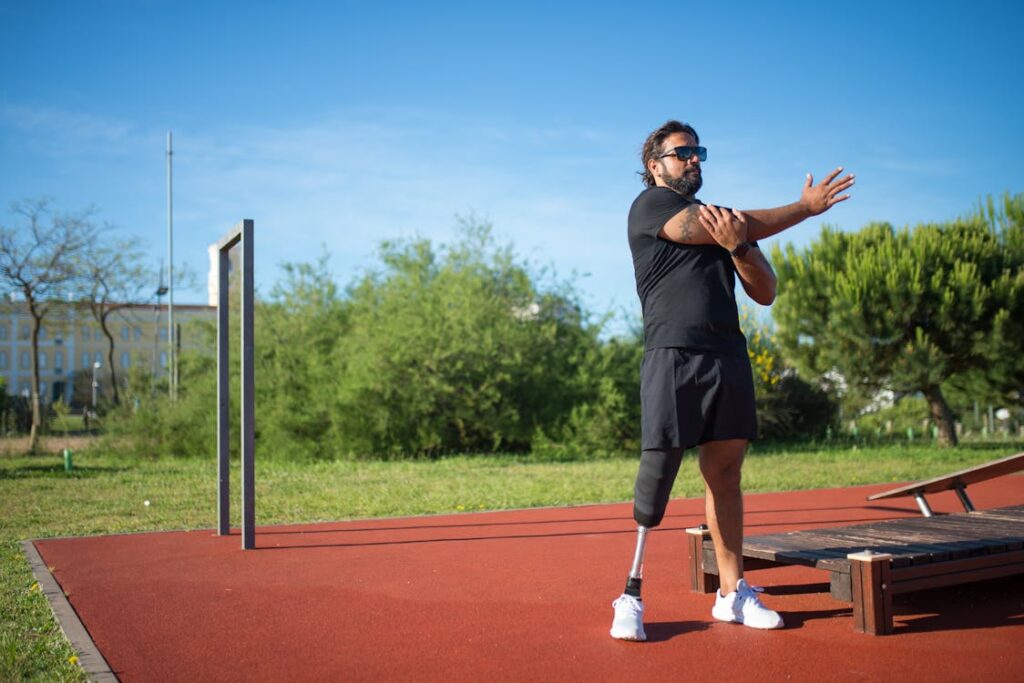
The Mechanics of Movement: Transtibial vs. Transfemoral
How the Body Moves with a Transtibial Prosthesis
When someone walks using a transtibial prosthesis, their knee remains a major asset. It still bends, supports weight, and plays a big role in controlling the stride.
This changes everything. During gait training, the focus is often on helping the person shift weight smoothly onto the prosthetic foot, learning how to roll over the foot naturally, and maintaining an even step length on both sides.
The knee joint adds stability and makes the walking pattern easier to manage. Because of this, people with transtibial amputations often pick up gait training quicker, especially if their residual limb is strong and well-shaped for socket fitting.
They don’t have to “think” about each step as much once the basic techniques are learned. The walking pattern can start to feel almost automatic after some time and practice.
What also helps is that most transtibial prostheses can easily incorporate energy-storing feet. These special feet absorb the energy when the heel strikes the ground and release it during push-off, which makes walking feel smoother and less tiring.
With proper alignment and training, many transtibial users can walk at near-normal speeds and even return to physically active lifestyles.
How the Body Moves with a Transfemoral Prosthesis
The story changes entirely with a transfemoral prosthesis. Since the knee is no longer present, it must be replaced with a mechanical one.
The person now has to control both the prosthetic knee and foot — often using only their hip muscles and body weight. This is a more advanced task. Every part of the gait cycle needs to be relearned, and it doesn’t always come naturally.
During training, a major focus is teaching the hip to take charge. The person must develop good control over hip flexion and extension to swing the leg forward without dragging or instability. Timing becomes everything.
Step too late, and the prosthetic foot may catch the ground. Step too soon, and the leg may not clear the floor. The process involves dozens of micro-corrections, many of which happen unconsciously once mastered — but are very challenging in the beginning.
The prosthetic knee is a critical part of this training. Some are mechanical, others are computerized. In both cases, the user must learn how to activate and trust it. In early rehab, many transfemoral users struggle with what’s called “knee buckling,” where the knee gives out during weight-bearing.
Preventing this requires proper alignment, correct socket fit, and excellent muscle strength, especially in the glutes and hip flexors. Training focuses heavily on these areas to ensure a stable, confident walk.
Energy Use and Fatigue
Walking with a prosthesis always uses more energy than walking with natural limbs — but how much more depends heavily on the type of amputation.
Transtibial users generally expend about 10 to 20 percent more energy. Transfemoral users, however, often use 60 to 100 percent more energy, especially early in the training process.
This increased demand shows up as fatigue. Transfemoral amputees may tire quickly, especially on uneven terrain, stairs, or slopes. Each step requires more thought, more muscle engagement, and more effort to maintain balance and control.
This is why rehab programs for transfemoral users usually include endurance training and frequent rest periods, especially in the beginning. It’s not about pushing harder — it’s about building sustainable strength over time.
On the other hand, transtibial amputees may face challenges with socket pressure or skin issues, but once those are addressed, they often move more freely and require fewer compensations.
Their gait pattern may be closer to normal, which reduces energy loss and makes long walks or full-day mobility more achievable.
The Role of Prosthetic Technology
Technology plays a supporting — and sometimes starring — role in gait training. For transtibial amputees, many of the prosthetic designs are fairly lightweight and straightforward.
While there are high-tech feet available, even basic designs can provide a smooth walking experience when combined with strong residual limb control.
In contrast, transfemoral prosthetics often rely heavily on advanced knee systems. Microprocessor knees are a game-changer here. They use sensors to read the user’s movement and adjust resistance in real-time.
This helps mimic a natural walking pattern and can dramatically improve safety, especially on slopes or stairs. But they also come with a learning curve.
The user must still move in a way the sensors can predict and support. That’s where gait training comes in — to teach the person how to move in harmony with the device.
Regardless of the level of amputation, technology alone isn’t enough. The person using it must be trained to get the best out of the prosthetic.
Gait training helps close the gap between what the technology can do and what the body needs.
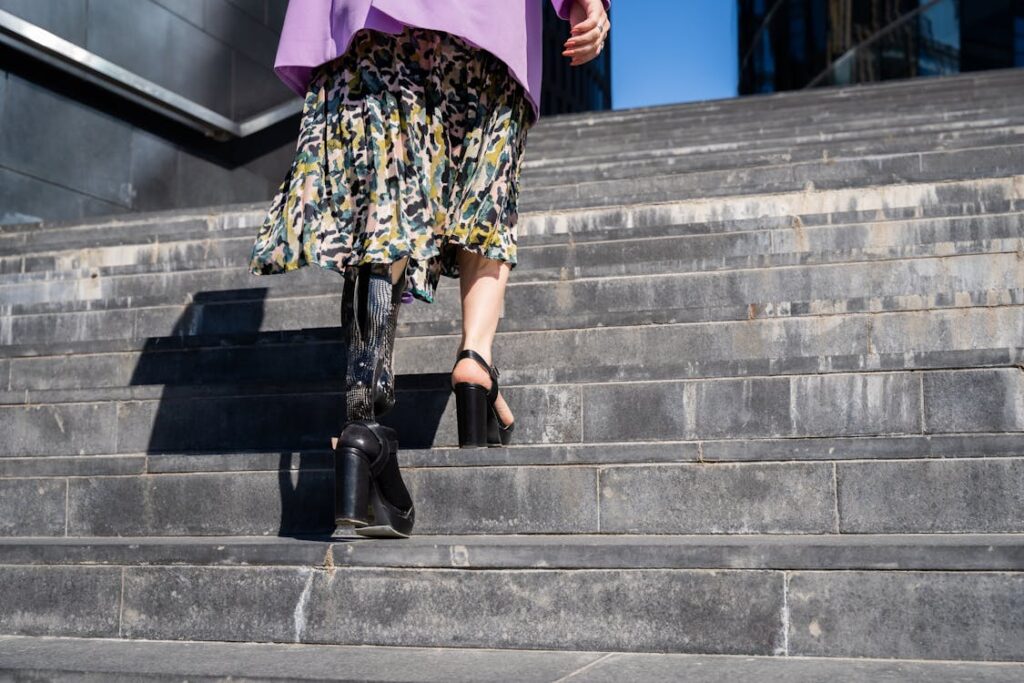
Common Gait Deviations and How They Differ
Understanding Gait Deviations
After a lower limb amputation, even with the best prosthesis and strong motivation, walking isn’t always perfect right away.
Most people, at some point, develop something known as a gait deviation. These are irregular walking patterns that form because the body is trying to compensate for the missing limb, the prosthesis, pain, or weakness.
Gait deviations can slow progress, lead to discomfort, and cause long-term issues if not corrected early.
What’s important to know is that the type of deviation a person develops often depends on the type of amputation — transtibial or transfemoral.
Each one has its own set of common issues, and the way those issues are addressed can be quite different.
Gait Deviations in Transtibial Amputees
Transtibial users often have more natural control over their gait, thanks to the preserved knee joint. However, they’re not completely free from problems.
One of the most common deviations is what’s called “vaulting.” This happens when the person rises up on the toes of their sound leg to help the prosthetic foot clear the ground.
It often occurs if the prosthesis is too long or the person lacks confidence in their ability to swing the leg forward.
Another issue can be “drop off,” where the person rolls off the toe of the prosthetic foot too quickly. This can make their step feel choppy or uncontrolled. It’s often caused by poor alignment or incorrect foot stiffness.
Some users also shift their weight away from the prosthetic side, causing a limp or uneven step. This may not seem serious at first, but over time, it can strain the joints and muscles on the healthy side of the body.
These deviations are usually addressed through alignment adjustments, physical therapy focused on weight distribution, and fine-tuning the prosthetic fit.
Since the knee is intact, therapists can work with a more natural gait cycle, and corrections can often be made relatively quickly with the right support.
Gait Deviations in Transfemoral Amputees
For transfemoral amputees, gait deviations are typically more complex. Since the knee joint is artificial, small issues with timing or weight shift can cause bigger problems.
One common deviation is “circumduction.” This is when the user swings the prosthetic leg out in a wide arc instead of lifting it straight forward. It usually happens when the person doesn’t trust the knee to bend properly or when hip flexors are weak.
Another frequent issue is “hip hiking.” The person raises their hip on the prosthetic side to help the foot clear the ground. This might help avoid tripping, but it uses extra energy and can cause lower back pain if it becomes a habit.
There’s also the problem of “knee instability.” When the prosthetic knee buckles or feels unsteady, users may keep it locked in a straight position, leading to a stiff, unnatural gait. This is safer in the short term but very tiring and hard on the hips over time.
Fixing these issues takes more than just adjusting the prosthesis. It often requires retraining the way the entire body moves.
Physical therapy focuses on building hip strength, improving coordination, and helping the user learn how to activate the prosthetic knee properly. It’s a slower process than with transtibial users, but with the right guidance, it leads to major improvements in both safety and comfort.
Importance of Early Correction
No matter what kind of amputation a person has, catching gait deviations early is crucial. If left unchecked, even small irregularities can lead to bigger issues.
Overusing one side of the body can wear down joints, cause muscle strain, and reduce overall mobility. That’s why frequent gait assessments during rehab are so important.
In transtibial gait training, therapists often look for smooth weight transfer, heel-to-toe motion, and even step length. In transfemoral training, they pay closer attention to hip control, knee movement, and stride timing.
By analyzing each phase of the step, they can spot problems before they become habits — and help the person build a more natural, efficient way of walking.
Early correction also boosts confidence. When people start to move better, they feel better. They become more independent, more willing to walk further, and less afraid of falling or tiring out.
That sense of progress is one of the biggest motivators during recovery, and it builds momentum that can carry them through the tougher parts of rehab.
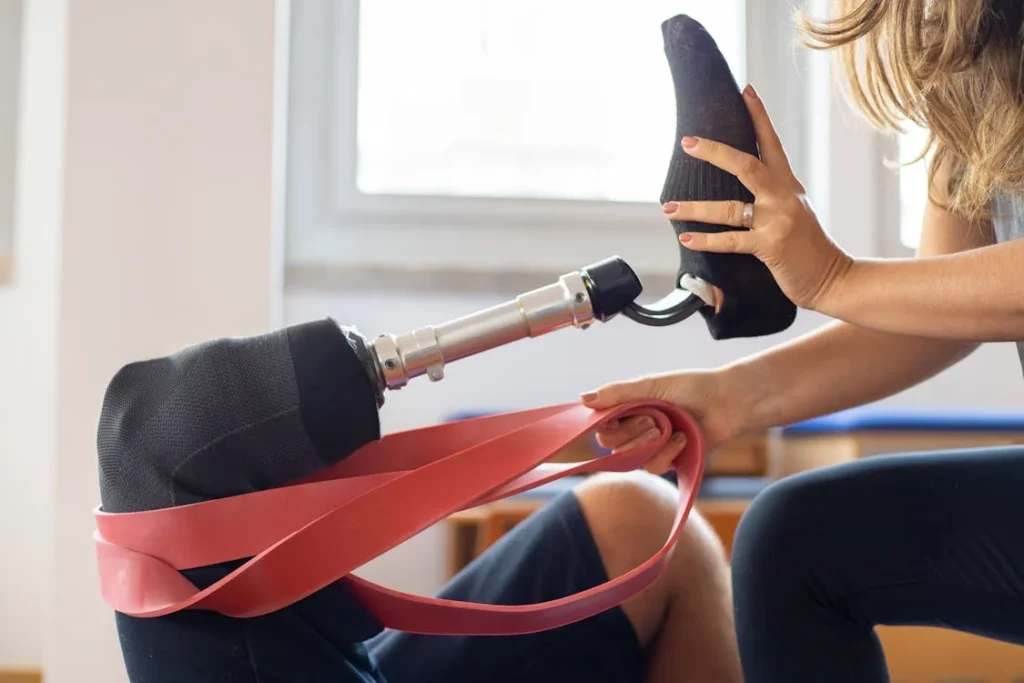
Training Techniques and Rehabilitation Approaches
How Gait Training Typically Begins
The first steps in gait training start early — often just days or weeks after surgery, once the wound has healed and the person is medically stable. But training doesn’t begin with walking. It starts with preparing the body.
Therapists focus on building strength, especially in the hips, thighs, and core. They also teach balance, posture, and coordination. These foundations are critical whether the person is using a transtibial or transfemoral prosthesis.
For transtibial amputees, early exercises often involve standing between parallel bars and shifting weight from side to side. This helps them get used to putting weight on the prosthetic foot.
Over time, they begin taking steps forward and backward, then progress to walking on flat ground. They may also practice heel-to-toe walking, turning smoothly, and walking at different speeds. Since the knee is still functional, they can often return to basic movement patterns more quickly.
Transfemoral amputees, on the other hand, spend more time in the preparation phase. Because the knee is artificial, they must learn how to activate it through hip movements and body mechanics.
Gait training often begins with controlled movements like tapping the prosthetic foot forward or backward while holding onto a support bar.
The goal is to understand how the prosthetic knee reacts to pressure and movement. From there, training builds gradually to include stepping, balancing, and eventually full walking.
Use of Parallel Bars and Mirrors
In both types of gait training, parallel bars play a huge role early on. They provide safety and confidence. Inside the bars, users can shift their weight, test their prosthesis, and take their first steps without the fear of falling.
Therapists can also guide their movement closely, correcting posture and motion in real time.
Mirrors are another powerful tool. Watching their own movement helps users understand what their body is doing. For transtibial users, a mirror can reveal uneven step lengths or poor weight transfer.
For transfemoral users, it can help identify when they are circumducting the leg or failing to bend the knee. Visual feedback reinforces correct patterns and helps break bad habits before they become permanent.
The Role of Muscle Strength and Coordination
Muscle strength matters — but not just in the legs. Walking with a prosthesis relies heavily on the hips and core. Without a strong core, balance becomes difficult.
Without strong hips, it’s hard to swing the prosthetic leg forward, especially for transfemoral users.
For transtibial users, strengthening the quadriceps, hamstrings, and gluteal muscles helps maintain stability and smooth movement.
These muscles help support the remaining limb and prevent overuse of the sound leg. Coordination drills — such as stepping onto foam surfaces or practicing turns — help develop smooth, confident walking in different environments.
For transfemoral users, strength training is even more important. Since they use their hips to control the knee and foot, the gluteus medius, gluteus maximus, and hip flexors become the stars of the show.
Rehab often includes resistance exercises, step-ups, and targeted balance work to engage these muscle groups fully. Coordination exercises are also key, because each step involves timing the knee’s motion precisely with the swing of the leg.
Progressing to Real-World Walking
Once basic skills are in place, training moves to more natural settings. The goal is always independence. People start walking on different surfaces — tile, carpet, grass — to learn how to adjust to each one.
They practice going up and down ramps, curbs, and eventually stairs. Therapists help them understand how to control their speed, stop safely, and turn without losing balance.
Transtibial users often find this transition smooth. Their knee joint gives them stability on slopes and stairs. With some practice, they learn to adjust foot placement and pressure naturally.
Transfemoral users take more time. They must build trust in their prosthetic knee, especially when descending stairs or walking downhill. Special techniques, like “step-to” patterns or using handrails strategically, are often introduced.
Eventually, the goal is to walk confidently without thinking too much about each step. That means being able to navigate a grocery store, a busy sidewalk, or a crowded family gathering with ease and comfort.
Gait training is successful not just when someone can walk — but when they can walk and live freely again.
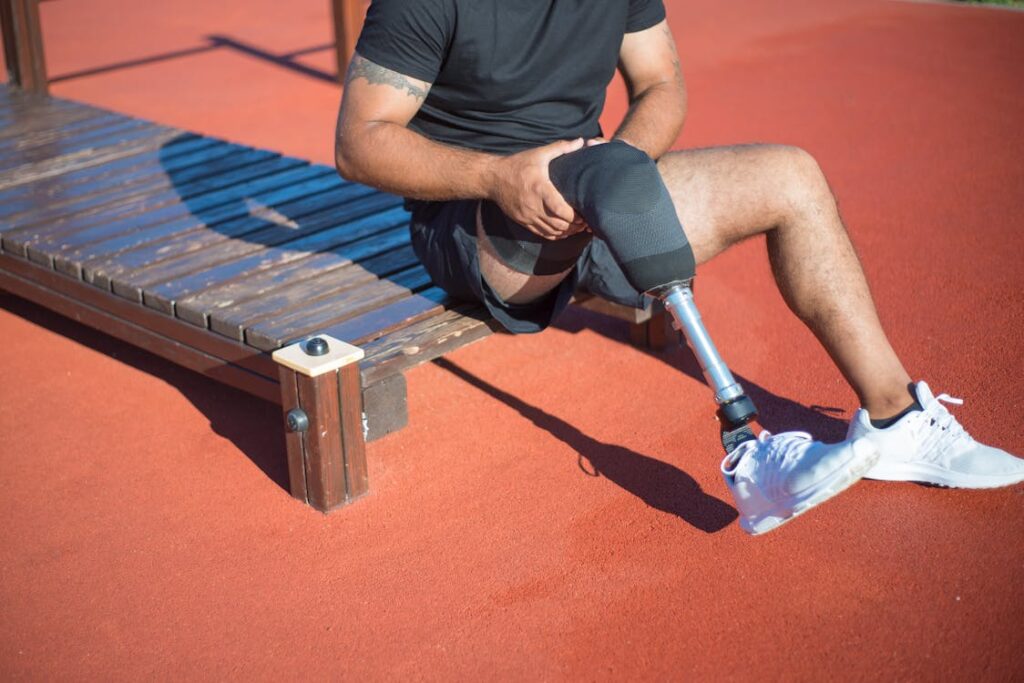
Emotional Resilience and the Psychology of Gait Training
The Invisible Battle Within
Every physical step taken during gait training is mirrored by a mental step — one that often goes unseen but is just as important. Losing a limb is not only a physical loss, it’s a deep emotional challenge.
Learning to walk again requires confidence, patience, and inner strength. These aren’t always easy to find, especially when progress is slow or setbacks happen.
This is where emotional resilience becomes the hidden engine behind every successful recovery.
For many people, the early days after amputation are filled with doubt. They wonder if they’ll ever feel “normal” again. They may feel embarrassed about how they walk, or worry that others are staring.
Some avoid social settings altogether during their rehab. These emotions — fear, frustration, sadness — are completely natural. But if left unaddressed, they can quietly stall progress.
Gait training helps bring structure and routine into this emotional storm. Each session becomes more than just an exercise — it becomes a way to rebuild identity.
Small wins, like taking a first step without support or walking the full length of a room, restore self-belief. Therapists often act as both coaches and counselors, providing encouragement that goes far beyond physical movement.
Different Journeys, Different Challenges
There is no one-size-fits-all recovery path. That’s especially true when comparing transtibial and transfemoral amputees. While both face psychological hurdles, the nature of those hurdles can vary significantly based on the level of the amputation.
Transtibial amputees, who still have their knee joint, may experience faster early progress. This can lead to early emotional boosts. They may feel more stable sooner, and that builds confidence quickly.
But even so, some feel pressure to recover “faster” because others assume their rehab should be “easier.” That pressure can create anxiety.
If they experience pain, socket discomfort, or gait problems, they may feel disappointed, even if their progress is completely normal.
Transfemoral amputees, meanwhile, often face a tougher road early on. Learning to walk without a biological knee is a steep hill. It can be frustrating when the prosthetic knee doesn’t respond as expected or when movement feels robotic.
Many transfemoral users are afraid to fall — and this fear can make them hesitant to walk naturally. These emotional blocks can sometimes be bigger obstacles than the physical ones. Support, understanding, and steady encouragement are essential.
It’s not uncommon for both groups to go through emotional highs and lows. One day they may feel strong and motivated, the next day they may feel exhausted or discouraged. This is a normal part of the journey, and recognizing this emotional wave helps people ride through it with less fear.
Reclaiming Confidence and Independence
The real goal of gait training isn’t just walking — it’s reclaiming freedom. Being able to move independently restores a sense of control. It allows people to return to work, social events, or family outings.
It gives them the option to walk into a room without help, to go for a short walk outside, or even to travel again. These aren’t just activities — they’re symbols of dignity and autonomy.
Confidence grows over time. It often starts with tiny victories. For a transtibial user, it might be learning to walk without crutches for the first time.
For a transfemoral user, it might be trusting the prosthetic knee enough to walk across an uneven path without overthinking every step. Each milestone brings back a piece of the person’s former life — and also builds something new.
Support groups, peer mentors, and online communities can also make a big difference. Talking with others who’ve gone through similar journeys helps normalize the struggle.
It reminds people they’re not alone — and that recovery doesn’t follow a perfect timeline.
The Role of the Rehab Team
Behind every successful gait training story is a team of dedicated people. Physical therapists, prosthetists, psychologists, and sometimes even family members all play vital roles.
They track progress, adjust the prosthesis, give feedback, offer encouragement, and create a safe space for emotional expression.
For transtibial users, rehab professionals focus on making movements smooth and natural, addressing socket fit and correcting minor gait issues before they grow.
For transfemoral users, the team becomes more involved in teaching compensatory strategies, building muscle memory for the artificial knee, and managing fatigue. Both paths require skill, patience, and a lot of trust between the user and their team.
When that trust is built, it becomes a foundation. Even on hard days — when setbacks happen or progress feels slow — that foundation keeps people grounded. It reminds them that progress is still being made, even if it doesn’t always feel like it.
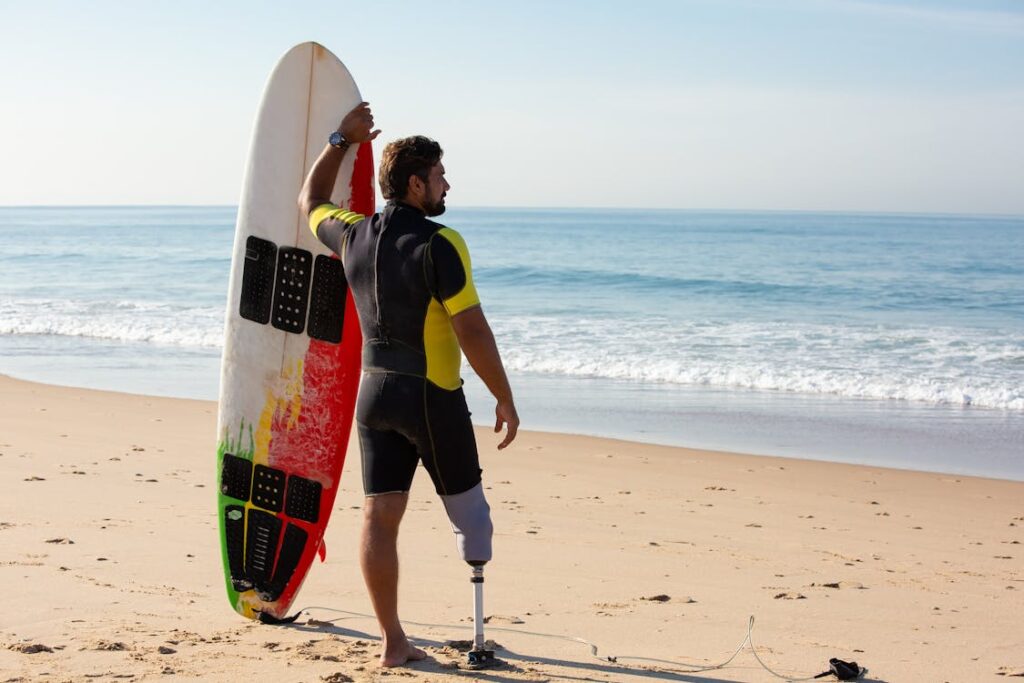
Long-Term Mobility: What to Expect Over Time
Life Beyond Rehab
Gait training doesn’t end when someone can walk from one end of a room to the other. It’s not just about finishing a rehab program — it’s about building a life that includes movement, independence, and confidence every single day. After formal physical therapy ends, the journey still continues.
Long-term mobility depends on how well the person adapts to daily life, how consistent they are with their exercises, and how well their prosthesis continues to serve them as their body changes.
Over time, many amputees see great improvements in how they walk and move. But progress can slow down or even reverse if certain things aren’t maintained. Muscles can weaken.
Gait patterns can fall apart. Prosthetic components can wear out or shift slightly, affecting balance and comfort. That’s why long-term care and attention are just as important as the first few weeks of rehab.
Transtibial amputees often enjoy greater ease of movement in the long run. Because the knee is intact, their gait may remain more natural and efficient, even years after their initial training.
They may find it easier to walk long distances, take part in recreational activities, or even run with the help of specialized prosthetics.
If they stay active and continue working on strength and flexibility, they can enjoy a high level of mobility for many years.
Transfemoral amputees, meanwhile, can also achieve strong, steady movement — but it usually requires more ongoing effort.
Since they must rely on hip control to manage the artificial knee, they often need to continue strengthening exercises long after formal therapy ends.
They may also need periodic adjustments to their prosthesis to ensure the knee’s timing and alignment are still accurate. Over time, many learn to walk confidently and smoothly, but it remains a physically demanding task, especially on stairs or rough terrain.
The Importance of Ongoing Adjustments
A prosthesis is not a “set it and forget it” device. As the body changes — weight shifts, muscles grow or shrink, posture adjusts — the way the prosthesis fits and functions can change too.
Even a small misalignment can cause discomfort or lead to bad habits. That’s why regular check-ins with a prosthetist are vital.
For transtibial users, small issues like skin irritation, pressure points, or socket loosening can sneak up slowly. These can cause the person to walk differently without even realizing it, eventually leading to pain or muscle imbalances. Catching these issues early can prevent bigger problems.
Transfemoral users face similar, but often more complex, issues. A change in how the socket fits can completely throw off the control of the prosthetic knee.
If the knee doesn’t activate at the right time, it can lead to tripping, instability, or fatigue. Regular follow-ups allow for adjustments that fine-tune the mechanics of the knee, improving both safety and comfort.
People who keep in touch with their care team and communicate clearly about what they feel — any pressure, pain, or changes in movement — tend to stay more mobile and independent in the long run.
Building Daily Routines Around Movement
Staying mobile after amputation doesn’t mean running marathons. It simply means building movement into everyday life.
That can be walking the dog, stretching in the morning, standing more often, or doing home exercises a few times a week. These routines keep the muscles active, prevent stiffness, and maintain good circulation in the residual limb.
For transtibial amputees, consistent movement helps prevent over-reliance on the sound leg. It also keeps the residual limb strong enough to manage pressure from the socket.
For transfemoral amputees, regular hip and core workouts are crucial. These support the extra workload the hips take on to manage the knee and foot mechanics.
Sometimes people reduce activity without even noticing. It might start with skipping a walk one day, then avoiding stairs the next, until suddenly they’re moving far less than before.
That’s when problems can start to creep in. A solid daily routine that includes walking, stretching, or light exercise makes a big difference.
Aging with a Prosthesis
Aging brings changes to everyone, whether or not they’ve had an amputation. Muscles lose mass, joints get stiffer, balance can decline.
These changes can make prosthetic use more challenging over time. But with preparation and ongoing care, most people can remain mobile well into their later years.
Transtibial amputees often maintain independence longer because their gait is closer to natural. With regular maintenance and some adjustments to the prosthesis, they can adapt well to aging.
Some may transition to using a cane or walker to feel safer, especially on uneven surfaces, but many continue walking independently for years.
Transfemoral users may experience more challenges, especially with endurance. Since they use more energy with every step, fatigue can become a bigger issue with age.
Adjustments to the prosthetic knee — switching to a more supportive model, fine-tuning resistance settings — can help. Balance training and fall prevention become priorities as well.
Most importantly, aging doesn’t mean losing independence. With the right mindset and support, many older amputees continue to walk, travel, and enjoy a rich, mobile life. The key is to stay proactive and involved in their own care.
Conclusion
Whether someone has experienced a transtibial or transfemoral amputation, the journey through gait training is deeply personal and transformative. The key differences between the two lie in the level of challenge, the role of remaining joints, and the way the body relearns to move. Transtibial users often benefit from a more natural gait and quicker adaptation, while transfemoral users face a steeper learning curve due to the loss of the knee, demanding greater strength, balance, and patience.
But no matter the path, both can lead to confident, independent walking with the right support, training, and mindset. What matters most is consistent effort, expert guidance, and emotional resilience. Gait training is not just about steps — it’s about regaining freedom, control, and a sense of normalcy.
With time, practice, and trust in the process, every amputee can take back their movement and reshape their future, one step at a time.



